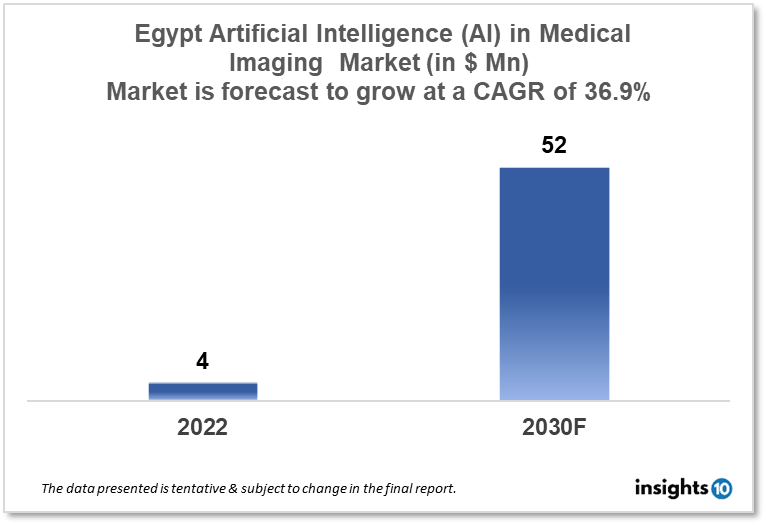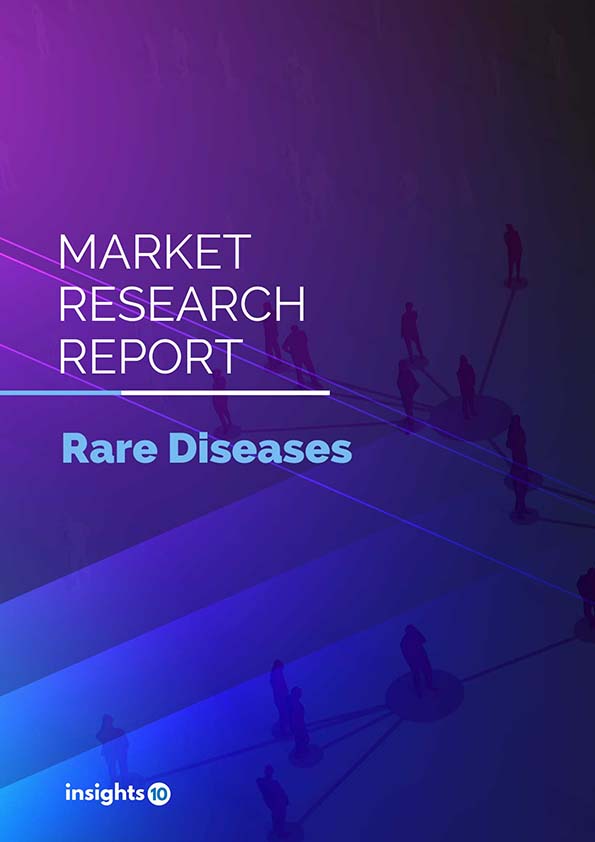Egypt Artificial Intelligence (AI) in Medical Imaging Market Analysis
Egypt,s Artificial Intelligence (AI) in Medical Imaging market size was valued at $4 Mn in 2022 and is estimated to expand at a compound annual growth rate (CAGR) of 36.9% from 2022 to 2030 and will reach $52 Mn. The market is segmented by AI technology, solution, modality, application, and end User. The demand for advanced medical imaging is increasing in Egypt due to the rising prevalence of chronic diseases and the aging population. Some of the key players in this market are InnoTech Medical Solutions, Nile University's Medical Image and Signal Processing (MISP) Lab, One Way Forward, BrainVISA Technologies, Scintilla for Medical Supplies, BMEYE, Crystal Technology, NewTech Medical Devices, Medispec, Faisal Misbah Mahmoud Radiology Center, and others.
Buy Now

Egypt Artificial Intelligence (AI) in Medical Imaging
Market Executive Summary
Egypt,s Artificial Intelligence (AI) in Medical Imaging market size was valued at $4 Mn in 2022 and is estimated to expand at a compound annual growth rate (CAGR) of 36.9% from 2022 to 2030 and will reach $52 Mn. Cairo: Cairo is the largest city in Egypt and is home to several leading healthcare providers. These providers are using AI-based medical imaging technologies for various applications, such as automated analysis of medical images, improving the accuracy of diagnosis, and reducing the time required for diagnosis. Additionally, the Cairo University Faculty of Medicine is conducting research on the use of AI in medical imaging, and several startups in the city are developing AI-based medical imaging solutions. Alexandria is the second-largest city in Egypt and is also home to several leading healthcare providers. These providers are using AI-based medical imaging technologies for various applications, such as automated analysis of medical images, improving the accuracy of diagnosis, and reducing the time required for diagnosis. Additionally, the Alexandria University Faculty of Medicine is conducting research on the use of AI in medical imaging. Moreover, upper Egypt, which includes cities such as Luxor and Aswan, is also witnessing the adoption of AI in medical imaging. Several healthcare providers in this region are using AI-based medical imaging technologies for various applications, such as automated analysis of medical images and improving the accuracy of diagnosis.
In Addition, the Red Sea Governorate, which includes cities such as Hurghada and Marsa Alam, is home to several healthcare providers that are using AI-based medical imaging technologies. These providers are using AI-based solutions for various applications, such as automated analysis of medical images and improving the accuracy of diagnosis.
Overall, Egypt is witnessing a rapid adoption of AI in medical imaging across different parts of the country. Healthcare providers in Cairo, Alexandria, Upper Egypt, and the Red Sea Governorate are using AI-based medical imaging technologies for various applications, such as automated analysis of medical images, improving the accuracy of diagnosis, and reducing the time required for diagnosis. Additionally, the Egyptian government is promoting healthcare innovation and providing support to healthcare providers to implement AI-based medical imaging technologies. Thus, the AI in the medical imaging market is expected to grow during the forecast period in UAE.

Market Dynamics
Market Growth Drivers
- Increasing demand for advanced medical imaging: The demand for advanced medical imaging is increasing in Egypt due to the rising prevalence of chronic diseases and the aging population. AI-based medical imaging technologies offer several advantages over traditional imaging methods, such as improved accuracy and faster diagnosis, which is driving the adoption of these technologies in the country.
- Government initiatives to promote healthcare innovation: The Egyptian government has launched several initiatives to promote healthcare innovation, including the use of AI in medical imaging. These initiatives are providing support to healthcare providers to implement AI-based medical imaging technologies, which is driving the growth of the market in the country.
- Growing number of healthcare providers: The number of healthcare providers in Egypt is growing, which is increasing the demand for AI-based medical imaging technologies. These technologies are enabling healthcare providers to provide better and more accurate diagnoses, which is improving patient outcomes and driving the growth of the market in the country.
- Increasing investment in healthcare: The government and private investors are increasing their investment in the healthcare sector in Egypt, which is driving the growth of the market for AI in medical imaging. These investments are enabling healthcare providers to implement advanced medical imaging technologies, including AI-based solutions, which is improving the quality of healthcare in the country.
Market Restraints:
- Lack of skilled professionals: The adoption of AI in medical imaging requires skilled professionals, such as radiologists and data scientists. However, there is a shortage of skilled professionals in Egypt, which is limiting the adoption of these technologies in the country.
- High cost of implementation: The implementation of AI-based medical imaging technologies can be expensive, which is limiting the adoption of these technologies in Egypt. Many healthcare providers in the country may not have the financial resources to invest in these technologies, which is slowing down the growth of the market.
- Limited access to healthcare: The access to healthcare in Egypt is limited, especially in rural areas, which is limiting the adoption of AI-based medical imaging technologies. The lack of access to healthcare is also limiting the demand for these technologies, which is slowing down the growth of the market in the country.
- Data privacy concerns: The implementation of AI-based medical imaging technologies requires access to patient data, which can raise data privacy concerns. The lack of clear data privacy regulations in Egypt is limiting the adoption of these technologies, as healthcare providers are hesitant to implement solutions that may violate patient privacy.
Competitive Landscape
Key Players
- InnoTech Medical Solutions
- Nile University's Medical Image and Signal Processing (MISP) Lab
- One Way Forward
- BrainVISA Technologies
- Scintilla for Medical Supplies
- BMEYE
- Crystal Technology
- NewTech Medical Devices
- Medispec
- Faisal Misbah Mahmoud Radiology Center
Healthcare Policies and Regulatory Landscape
Policy changes and Reimbursement scenario
AI in medical imaging in Egypt. However, the country has a regulatory body called the Egyptian Drug Authority (EDA) that oversees medical devices and drugs, and any AI-related medical imaging products would likely fall under their jurisdiction. It is possible that the EDA will develop regulations and guidelines for AI in medical imaging in the future as the technology continues to advance and be more widely used in healthcare.
1. Executive Summary
1.1 Digital Health Overview
1.2 Global Scenario
1.3 Country Overview
1.4 Healthcare Scenario in Country
1.5 Digital Health Policy in Country
1.6 Recent Developments in the Country
2. Market Size and Forecasting
2.1 Market Size (With Excel and Methodology)
2.2 Market Segmentation (Check all Segments in Segmentation Section)
3. Market Dynamics
3.1 Market Drivers
3.2 Market Restraints
4. Competitive Landscape
4.1 Major Market Share
4.2 Key Company Profile (Check all Companies in the Summary Section)
4.2.1 Company
4.2.1.1 Overview
4.2.1.2 Product Applications and Services
4.2.1.3 Recent Developments
4.2.1.4 Partnerships Ecosystem
4.2.1.5 Financials (Based on Availability)
5. Reimbursement Scenario
5.1 Reimbursement Regulation
5.2 Reimbursement Process for Diagnosis
5.3 Reimbursement Process for Treatment
6. Methodology and Scope
rtificial Intelligence (AI) in Medical Imaging Market Segmentation
By AI Technology
- Deep Learning
- Natural Language Processing (NLP)
- Others
By Solution
- Software Tools/ Platform
- Services
- Integration
- Deployment
By Modality
When compared to CT scans, magnetic resonance imaging can produce pictures that are free of imperfections. Due to its efficiency in obtaining details and better-quality pictures of soft tissues, the MRI is frequently seen as a superior alternative to X-rays. Utilizing optical coherence tomography, three-dimensional interactions between the retina and membranes are made possible in order to control the vitreoretinal disease.
- CT Scan
- MRI
- X-rays
- Ultrasound Imaging
- Nuclear Imaging
By Application
The market is dominated by the digital pathology segment, which can be linked to pathologists' rising productivity. A validation tool for image analytics is provided by digital pathology, helping pathologists process more slides in less time. This facilitates early illness identification and quicker therapy initiation. AI and digital pathology also assist doctors in making patient-centered decisions. The oncology market is also expected to grow in popularity as more individuals become aware of cancer and its increased incidence in the public. Personalized therapy is made possible by artificial intelligence algorithms that identify and comprehend the nature of malignancies. The second section focUses on AI-driven diagnostic imaging for the heart, brain, breast, and mouth.
- Digital Pathology
- Oncology
- Cardiovascular
- Neurology
- Lung (Respiratory System)
- Breast (Mammography)
- Liver (GI)
- Oral Diagnostics
- Other
By End Use
The market is dominated by the healthcare sector. This is becaUse hospitals are widely dispersed and accessible; hence, many patients like hospitals. The market for medical imaging AI is also anticipated to benefit from favorable reimbursement regulations. During the anticipated time, diagnostic centers are anticipated to grow in popularity. This may be attributable to elements including rising patient awareness and a desire for diagnostic procedures and tests, all of which are fueling the market's expansion. Due to its ease in providing high-quality medical facilities in remote places, particularly rural ones, the ambulatory category is expected to develop at a quicker CAGR throughout the projection period. The availability of qualified surgeons and a surplAustralia of the necessary equipment are contributing to the expansion of the hospital market. Government assistance in emerging nations is likely to boost hospital infrastructure and technologies throughout the forecast period, which is anticipated to caUse the hospital segment to see growth.
- Hospital and Healthcare Providers
- Patients
- Pharmaceuticals and Biotechnology Companies
- Healthcare Payers
- Others
Methodology for Database Creation
Our database offers a comprehensive list of healthcare centers, meticulously curated to provide detailed information on a wide range of specialties and services. It includes top-tier hospitals, clinics, and diagnostic facilities across 30 countries and 24 specialties, ensuring users can find the healthcare services they need.
Additionally, we provide a comprehensive list of Key Opinion Leaders (KOLs) based on your requirements. Our curated list captures various crucial aspects of the KOLs, offering more than just general information. Whether you're looking to boost brand awareness, drive engagement, or launch a new product, our extensive list of KOLs ensures you have the right experts by your side. Covering 30 countries and 36 specialties, our database guarantees access to the best KOLs in the healthcare industry, supporting strategic decisions and enhancing your initiatives.
How Do We Get It?
Our database is created and maintained through a combination of secondary and primary research methodologies.
1. Secondary Research
With many years of experience in the healthcare field, we have our own rich proprietary data from various past projects. This historical data serves as the foundation for our database. Our continuous process of gathering data involves:
- Analyzing historical proprietary data collected from multiple projects.
- Regularly updating our existing data sets with new findings and trends.
- Ensuring data consistency and accuracy through rigorous validation processes.
With extensive experience in the field, we have developed a proprietary GenAI-based technology that is uniquely tailored to our organization. This advanced technology enables us to scan a wide array of relevant information sources across the internet. Our data-gathering process includes:
- Searching through academic conferences, published research, citations, and social media platforms
- Collecting and compiling diverse data to build a comprehensive and detailed database
- Continuously updating our database with new information to ensure its relevance and accuracy
2. Primary Research
To complement and validate our secondary data, we engage in primary research through local tie-ups and partnerships. This process involves:
- Collaborating with local healthcare providers, hospitals, and clinics to gather real-time data.
- Conducting surveys, interviews, and field studies to collect fresh data directly from the source.
- Continuously refreshing our database to ensure that the information remains current and reliable.
- Validating secondary data through cross-referencing with primary data to ensure accuracy and relevance.
Combining Secondary and Primary Research
By integrating both secondary and primary research methodologies, we ensure that our database is comprehensive, accurate, and up-to-date. The combined process involves:
- Merging historical data from secondary research with real-time data from primary research.
- Conducting thorough data validation and cleansing to remove inconsistencies and errors.
- Organizing data into a structured format that is easily accessible and usable for various applications.
- Continuously monitoring and updating the database to reflect the latest developments and trends in the healthcare field.
Through this meticulous process, we create a final database tailored to each region and domain within the healthcare industry. This approach ensures that our clients receive reliable and relevant data, empowering them to make informed decisions and drive innovation in their respective fields.
To request a free sample copy of this report, please complete the form below.
We value your inquiry and offer free customization with every report to fulfil your exact research needs.









































